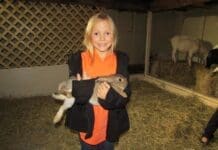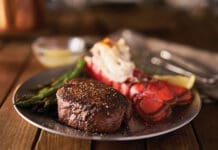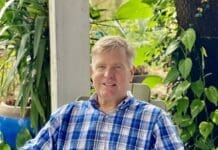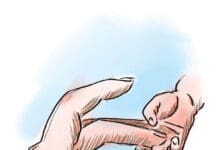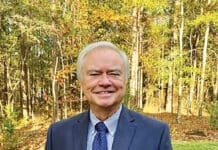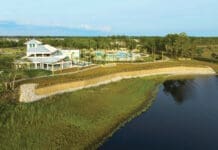By Sean Dietrich
 I am taking my dog for a walk among the thick longleaf pines of the West Floridian woods. I am on a trail that cuts across marshland, swampland, farmland, grassland, and every other kind of land.
I am taking my dog for a walk among the thick longleaf pines of the West Floridian woods. I am on a trail that cuts across marshland, swampland, farmland, grassland, and every other kind of land.
Autumn is in its infancy in the Sunshine State. The air is cool. And I just read in the newspaper that there have been 712,000 cases of COVID-19 within our boundaries. Not to mention all the damage from Hurricane Sally.
Oh, it’s been quite a year.
I am here because I needed to see some trees. I needed a pine-scented breeze. I needed this.
The Florida woods are not like other places. You don’t get a sense of how big they are when you’re in them. You can only feel their immense size. It’s disorienting. Your phone loses reception, so you have no GPS to gauge your mileage. And even if you did, who cares?
You don’t come out here to play on phones.
The woods are a cathedral. These trees do something to you. They remind you that this world isn’t exactly what we think it is.
You leave your house and immediately you’re within the Age of Concrete. You see only what highway engineers want you to see. Overpasses, big box hardware stores, flashing lights, signage, and here comes another strip mall. Goodness knows how much we love our strip malls.
But that’s not the world. That’s not life. It’s only one tiny part.
America is one third forest. There are the boreal forests in Alaska, the tropical forests of Hawaii, the majestic old growths of Appalachia. Maine is 89 percent forest, West Virginia is 78 percent forest. My home state is over 50 percent forest.
I have a friend who once hiked the entire Florida Trail, which cuts 1,000 miles of old forest from Big Cypress National Reserve to Fort Pickens.
I’ve also hiked and camped small parts of the Florida Trail with my dog. To camp in the middle of these trees is haunting. You hear sounds at night that will totally freak you out. A possum becomes a Florida panther. And a gecko sounds just like an adult alligator.
I once found a bobcat sifting through my food bag. I shined a flashlight at it. The thing was the size of a lap dog. It hissed at me before finally romping off into the tallgrass. I’ve never been so grateful to have a change of pants.
In the deep woods, many longleafs still bear the old catfaces from Florida’s turpentining days. At one time Florida was covered in turpentining mills. Turpentiners would carve V-shaped whiskers into trees with machetes and drain the trees’ lifeblood into buckets.
Now and then, you still find these old trees, scarred and mangled. You feel sorry for the old trees because they were stripped, bled, and you know that had to hurt.
But then, you feel admiration for all evergreen conifers in this wilderness. You’re not sure why. Things are different out here. Out here they become your pals.
Maybe it’s because these trees are part of your blood. Literally. Floridians breathe in pine pollen December through May. If doctors were to draw our blood, they would see yellow dust in it.
These trees have always been in our line of vision. On every highway. Every backwater. Behind every filling station. And in the night, when you take out the garbage, they are all around you, groaning in the faint breeze like they are alive.
Because they are alive.
Longleaf pines are much more than giant pieces of celery. They’re breathing creatures. You might not know that, but they are.
A pine can communicate with other trees. Its roots travel miles beneath soil, forming a veiny interweb scientists call mycorrhizal networks. The fine, hairlike ends of these herculean root systems join with fungal life and form a kind of complex internet among trees.
These trees share water, nutrients, food, and send distress signals to each other. A longleaf has a signaling system it uses to spread news of draughts, disease, or insect attacks, and nearby trees will change their behavior.
When the destructive sawfly invades, for example, the longleafs don’t just sit on their stumps. A tree will change her scent. Soon all her friends are reacting. The new fragrance drifts throughout the woods, setting off a chain reaction across the behemoth forest. The scent attracts chalcid wasps who swarm into the woods to save the day from the wicked sawfly.
And I think that’s pretty cool.
But sometimes I lose sight of it all. Life itself. And how majestic it all is. I forget that it’s happening all around me. I forget the resilience of it. I forget about the beauty of trees.
These pines were here before me; they will outlive me. They were here when the Conquistadors needed masts for their square-rigged ships.
They were here when fledgling colonies needed lumber. And when turpentiners demanded their sap to manufacture warship paint, the trees gave blood. They resisted fires, hurricanes, tornadoes, industrialism, commercialism, and subdivision-ism. They can endure nearly anything except guys with chainsaws.
They are the most lovely creatures, and it’s sad how often I overlook them. How can a guy grow up beside the most complex and marvelous things to ever exist and hardly notice them?
But I notice them today. They’re strong, thick-skinned, broad-limbed, humble to a fault, and long lasting. They will keep growing in the face of heartache, outlasting disease, famine, dry spells, and rare snows. They will keep being sturdy, no matter how sad this world gets.
And so will you, Florida.
So will you.


